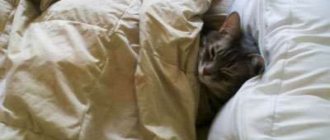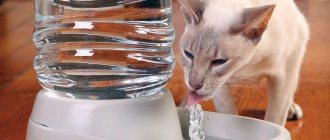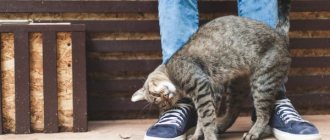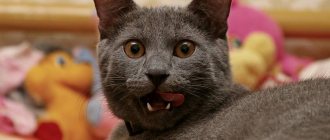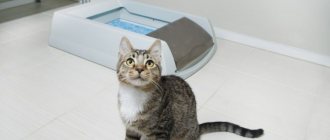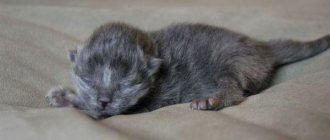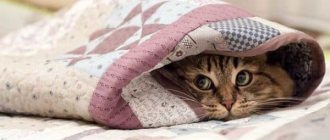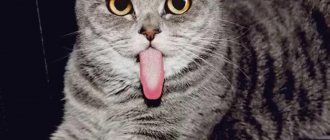Why does a cat twitch and meow in its sleep? The first thing that comes to mind for most people who observe this behavior of a pet is that the cat is dreaming. Of course, this is the simplest explanation. However, the reason why a pet is active during rest may also be the health status of the animal.
Often, the reason for twitching paws and screams is not the plot of the dream at all, but much more prosaic things, namely, illness. A reason to suspect a problem in your cat’s health is regular twitching of the limbs or their spasms.
When should you worry?
If a cat's paws twitch in its sleep, this is not always a cause for alarm. You should keep an eye on your pet. You need to observe not so much in a dream as at the moment of awakening. The state of the animal is immediately visible: if the cat is happy, she has the perky look of a hooligan or, on the contrary, the mysterious arrogant look of an empress, she stretches and yawns, purrs briefly and abruptly.
You should be concerned if your cat twitches too often during sleep. When your pet looks unhappy, tired and lethargic when waking up, you should immediately contact a veterinarian.
Doctors' help is also required in cases where a cat twitches its paws in its sleep and then wakes up sweaty and with wet fur. This is a symptom of internal problems in the body, which may be related to hormonal balance or kidney function.
Persians who eat dry food often suffer from kidney failure and urolithiasis. Persian cats prone to such ailments always first begin to twitch and sweat, and only after some time do characteristic symptoms appear - changes in the concentration, color and smell of urine.
When observing a sleeping twitching cat, you need to carefully touch it, trying not to wake the pet. This should be done in order to understand whether the animal has a spasm - contraction of muscle fibers. It is impossible to determine this visually. If your pet's body or legs are cramping, you should immediately consult a doctor.
What to do if your cat twitches in his sleep?
Representatives of the feline species spend most of their lives sleeping. These animals love to settle down in a cozy, safe place and choose the most comfortable position. Sometimes a cat twitches in its sleep.
A person, seeing such movements, often begins to worry and wonders whether such a phenomenon is normal.
What happens to an animal during sleep? What kind of movements during rest can be evidence of the development of pathologies? The answers to such questions are most interesting and important for animal owners.
Features of cat sleep
Scientists have conducted studies on cats' sleep. It was found that the normal sleep of this species of animals has 3 phases :
- superficial, it can be compared to a state of drowsiness, in which the individual is able to control the environment and danger;
- slow sleep, it is characterized by relaxation of the animal’s muscles, a decrease in blood pressure, slowing of breathing and heartbeat, the cat can make slow movements of the eyeballs under closed eyelids;
- REM sleep, usually lasts 6-7 minutes, during which changes occur - the breathing rate alternates between increasing and decreasing, the rhythm of the heart changes, blood pressure can increase, the eyes under the eyelids can move quickly, twitching of the paws, tail, ears, and whiskers occurs in sleep .
© shutterstock
Research has reliably confirmed that it is the rapid phase of sleep that is the period when the animal sees dreams filled with emotions, sights and sounds. The phases of sleep replace each other, and the cat’s behavior changes and corresponds to each of them.
What can a cat dream about?
What kind of dreams does a cat have? Scientists believe that an animal in a dream is capable of experiencing many pleasant and not so pleasant emotions, while at the same time seeing the real world around them and hearing its sounds :
- joy;
- aggression;
- fear;
- interest;
- hunting instinct.
It is hunting, the pursuit of prey, that, according to researchers, are the main plot lines of cat dreams. This leads to the conclusion that a sleeping cat’s paw twitches not because of illness, but because of the vivid pictures of life that the animal dreams of.
Locomotor activity of kittens during sleep
Researchers explain why a kitten twitches in its sleep much more often, more energetically and longer than its adult relatives.
They claim that a young cat between the ages of birth and one and a half years has a long REM sleep phase, which takes up to 80% of his total rest time.
During the period of active growth and maturation in animals, the nervous system is in the stage of development and formation, therefore, during sleep, kittens experience more vivid emotions than sexually mature individuals.
Kittens are able to fall asleep in an uncomfortable place; often the position chosen for rest causes bewilderment among the owners due to its unnaturalness.
After falling asleep, a young male cat begins to vigorously move and move its paws, often twitch its whole body, roll over and radically change its position in space. Sometimes his eyes may be slightly open, which is completely normal for a baby.
The special structure of its visual organs suggests the presence of a third eyelid, which has the appearance of a transparent film that reliably protects the eyes. Kittens make sounds - they can meow with varying intensity, purr.
© shutterstock
The movement of a young sleeping cat can help to understand the storylines of his dreams - games with brothers and sisters, first fights, walks around the house and in nature, meeting other animals, for example, a dog or adult relatives, hunting birds, insects or rodents. Sleepy smacking and sucking movements are explained simply - the baby is enjoying delicious mother's milk.
Motor activity during sleep of an adult cat
It is normal for a cat to twitch slightly during sleep once it has passed adolescence. Adaptation of an animal in the outside world and among “its own kind”, strengthening its nervous system, completing the construction of “owner-pet” relationships contributes to its psychological stability. The cat does not experience significant stress and therefore sleeps more peacefully.
In an adult, REM sleep is accompanied by:
- infrequent and not pronounced movements of the paws;
- twitching of the lip, mustache, ears;
- motor activity of the tail;
- rare screams, meows, growls.
If a cat older than two years old experiences emotions characteristic of a kitten in a dream, it is highly likely that it may be diagnosed with behavioral changes - increased nervousness, aggressiveness. It is difficult for such animals to adapt close to humans, and sometimes living together becomes impossible.
When to Seek Veterinary Help
The special behavior of a cat in a dream may indicate the development of some dangerous pathological conditions in it. Cat owners should know their symptoms in order to prevent the development of diseases and not miss the time when treatment can be most effective.
© shutterstock
Seizure
In some situations, cats often twitch in their sleep, and such movements are similar in nature to convulsions. This condition requires immediate help for the pet, there is no time to waste, you must immediately start waking up the cat.
The duration of the animal's awakening process must be assessed - a healthy animal is able to fully wake up quickly, within 15 seconds.
If the process drags on against the backdrop of ongoing convulsions, the cat has difficulty getting out of sleep, remains half-asleep and lethargic - it requires a veterinary examination and, possibly, treatment.
Symptoms confirm seizure:
- labored breathing;
- the animal is unable to stand or simply raise and hold its head;
- cannot swallow saliva and chokes on it.
Situations are especially dangerous when, due to convulsive manifestations, the owner cannot wake up his cat or, after waking up, the animal loses consciousness.
Such conditions indicate that the convulsions have not ended and the process may repeat.
If the seizure is of a recurring nature, the symptom may indicate pathologies of the nervous system, the possibility of the development of tumor processes in the pet’s brain. Often, convulsions in a dream end in the death of the cat.
Cat during pregnancy and after birth
Maximum attention to the cat's behavior from the owner is required during her pregnancy and after the birth has occurred. It is during periods associated with the expectation and birth of offspring that it is necessary to monitor the female’s sleep patterns, movements accompanying rest, and monitor the possibility of seizures.
A seizure may occur while the cat is resting after giving birth. It is the main symptom of the development of pathology - postpartum preeclampsia. Its other symptoms are :
- severe anxiety of the animal, excitement, or vice versa, falling into an inhibited state;
- body temperature rises;
- breathing and heart rhythm disturbances;
- salivation increases;
- loss of consciousness occurs.
© shutterstock
Seizures begin with light muscle contractions, which then become prolonged - the cat may take unnatural positions, fall on its side, or lose motor coordination. The condition requires urgent professional assistance.
Other causes of cat seizures during sleep
Why might domestic cats have seizures while sleeping? These symptoms are associated with various reasons. :
- the presence of signs of the development of viral or infectious diseases (with a significant increase in body temperature);
- when metabolic processes in the animal’s body are disrupted due to hypothermia, the consequences of heat stroke;
- lack of water, dehydration - metabolic processes are inhibited, disrupted, the internal organs of the animal do not receive enough oxygen;
- intoxication of the cat’s body, which occurs when poisoned by medications, poisons, components included in household chemicals, fertilizers, building materials, paints, varnishes;
- hormonal imbalance;
- presence of heart and vascular diseases;
- consequences of traumatic brain injuries;
- respiratory diseases;
- helminth infection;
- imbalance of vitamins and microelements.
A change in their emotional state can cause seizures during sleep in cats.:
- severe fear;
- life-threatening danger;
- getting injured;
- change of place of residence.
The cat's owner must periodically monitor his sleep in order to avoid the development of dangerous diseases and deterioration of his well-being.
Source: https://KoshkaMurka.ru/8221-chto-delat-esli-kot-dergaetsya-vo-sne.html
What can cause twitching?
A sleeping cat may twitch for a variety of reasons. In order for the doctor to be able to narrow down the range of possible sources of this phenomenon, careful observation of the pet is required.
A cat's twitching while resting is most often caused by the following:
- neurological pathologies;
- stress;
- diseases of internal organs;
- pathogenesis of the psyche;
- inflammation of the brain;
- infection with helminths or external parasites.
The presence of muscle spasms, severe convulsions, and contraction of the limbs is always a signal of a serious illness. Unlike simple fingering and reflexive twitching of the paws, this condition is not caused by a dream or stress.
What causes seizures?
A cat twitches convulsively in its sleep due to the presence of an internal disease or a pathological process caused by parasites. The most common causes of seizures are:
- tumors;
- lymph inflammation;
- brain diseases;
- mental pathologies;
- deficiency of calcium or other substances;
- disturbances in the functions of the peripheral nervous system;
- infection by parasites and others.
When figuring out why cats twitch in their sleep, doctors identify specific diseases, including:
- non-purulent meningoencephalitis;
- cerebral ischemic encephalopathy;
- viral infectious peritonitis;
- toxoplasmosis;
- hyperparathyroidism;
- helminthiasis;
- ticks and fleas;
- excess medications or other drugs and additives in the blood;
- microstroke;
- lack of vitamin B;
- urolithiasis disease;
- renal failure;
- anemia.
Each of these diseases is very serious, but the most dangerous of them are meningoencephalitis, encephalopia and peritonitis.
Features of cat sleep
Scientists have conducted studies on cats' sleep. It was found that the normal sleep of this species of animals has 3 phases :
Research has reliably confirmed that it is the rapid phase of sleep that is the period when the animal sees dreams filled with emotions, sights and sounds. The phases of sleep replace each other, and the cat’s behavior changes and corresponds to each of them.
About meningoencephalitis
Non-purulent meningoencephalitis is most often diagnosed by doctors in a situation where a cat twitches in its sleep. The difference between this disease and ordinary encephalitis and classic meningitis is the absence of accumulations of pus inside the skull. The pathogenesis itself combines some processes characteristic of both diseases. This disease is an inflammation of the membranes of the brain and itself. It occurs most often in the form of complications and consequences of such ailments as:
- viral infections;
- hepatitis;
- leptospirosis;
- plague;
- ascariasis and mycosis.
In addition, the disease develops after bruises, various injuries to the skull and spine, and prolonged sepsis. Cramps during sleep are one of the earliest symptoms of this disease. But if you consult a doctor, your pet’s treatment will be successful and quickly enough.
Reasons Why Kittens May Shake
Let's look at 13 popular reasons why a kitten may be shaking:
Photo: Siamese kittens | Dreamstime.com
- Staying in a cold room or outside in freezing temperatures.
It is believed that a comfortable air temperature for newborn kittens is +31 degrees, for older pets – about +24 degrees. If there is no heating in the room in winter or late autumn or the windows are wide open, then the room temperature can become significantly lower than 24 and even more so 31 degrees, which can lead to hypothermia and trembling in kittens. Other signs besides trembling that indicate that the cat is cold are drowsiness, apathy, slow breathing, rare pulse, low body temperature (in kittens less than 38.5 degrees). By the way, even in summer, in drafts, a kitten may tremble after bathing if it gets cold; - State of excitement.
Now we are not talking about sexual arousal, but about the reaction, for example, to delicious food. The kitten may also tremble during play, when it gets into a rage. Older kittens may tremble at the sight of a bird outside the window or, say, a dragonfly. Naturally, tremor in such cases is short-term and safe; - Movements in sleep.
Many owners have probably noticed that their kittens' paws tremble, lips move, and ears move during naps or deep sleep. That's right, because cats also dream, according to scientists. Moreover, the owner can even guess what exactly the purr is dreaming about. So, trembling may mean that the pet is having a bad dream (a harsh neighbor’s dog, for example), the movement of the paws means that in the dream the pet is running somewhere, and so on; - Fright.
If the kitten is trembling and meowing, trying to run away, if its fur is raised on end and its eyes are bulging, it may be simply scared. Small animals can become frightened by anything, for example, a noisy stranger or the loud noise of a vacuum cleaner; - Stress.
Anything can put a little purr out of action: a change of place of residence, early weaning from its mother, buying new rattling toys, and so on. When stressed, many kittens tremble, lick their fur furiously, eat poorly or excessively, and become overly affectionate or aloof; - Poor functioning of the digestive tract.
Some owners notice that their kitten trembles after eating. This is due to a strong contraction of the muscles of the stomach and intestines, as a rule, after eating solid food, which is too early for a baby kitten to eat; - Sexual desire.
When we talk about kittens, we mean not only tiny pets under 2 months of age, but also teenage animals over 5 months of age who are beginning to be interested in the opposite sex. During sexual heat, many cats and seals tremble, meow loudly, rub against furniture or the owner’s legs, females’ genital area swells, males place marks; - Lack of B vitamins.
B vitamins (thiamine, niacin, riboflavin, biotin, etc.), which enter the body of kittens with mother's milk or adult food, ensure the normal functioning of the nervous system, prevent stress, and are responsible for energy metabolism. If there is not enough vitamin B, then the kitten trembles and is lethargic, grows poorly and slowly, its fur looks dull and its skin peels; - Infectious diseases.
If the kitten is trembling and lethargic, some infectious disease, for example, leptospirosis, immunodeficiency virus, panleukopenia, or rabies, may be to blame. General signs of the listed ailments are loss of appetite and weight loss, strong salivation, temperature and fever, change in the shade of the mucous membranes (yellowness, redness or blanching), souring of the eyes, vomiting and diarrhea are possible; - Poisoning.
It also happens that a small kitten is trembling due to toxic damage to the body, for example, lead, certain medications (especially aspirin), ethylene glycol and other substances dangerous to animals. Symptoms of poisoning other than tremor are cramping abdominal pain, nausea and vomiting, problems with stool (diarrhea, sometimes constipation), rapid breathing with wheezing, impaired coordination of movements, bleeding (in case of aspirin poisoning), loss of consciousness; - Gastrointestinal diseases.
If there is a problem with the digestive system, it happens that the kitten is constantly trembling. Tremor is observed, for example, with colitis, proctitis, pancreatitis. Trembling is not the most striking symptom of the listed diseases; a vigilant owner may notice the following: upset stool in the form of diarrhea, the presence of mucus and blood in the stool, nausea or vomiting, a slight rise in temperature, pain during defecation, rapid breathing; - Diseases of the endocrine system.
Tremor can be observed in kittens, for example, against the background of insulinoma or hypoglycemia. Fortunately, such problems do not occur very often in children, but still. As a rule, when there are endocrine problems, in addition to strong tremors, strong heartbeat, weakness, convulsions, and appetite disturbances will be observed (the animal may either not eat at all or literally go crazy from gluttony). The behavior of kittens with such problems may be unusual (too intrusive, affectionate or aggressive); - Diseases of the nervous system.
Severe trembling occurs in kittens due to epilepsy, encephalitis, and meningitis. Other signs of these diseases, in addition to tremors, are rapid pulse and breathing, vomiting, severe salivation, seizures, unsteady gait, fever, restless behavior, and in some cases, muscle paralysis develops.
About encephalopathy
Cerebral ischemic encephalopathy is a softening of certain areas in the brain. The exact causes of this disease are unknown to veterinarians, and the accompanying symptoms vary significantly in different animals.
Without treatment, a pet with such a disease will inevitably degenerate completely, losing not only individual personality traits, but also basic skills. This doesn't just apply to maintaining hygiene. For example, a cat may forget how to walk or eat.
When is it necessary to consult a veterinarian?
The painful condition of an animal is in any case a reason to visit a veterinary clinic with your pet, but you should pay special attention to situations where the pet is in one of the risk groups. Thus, convulsive conditions are dangerous for:
If a particular animal does not fall into one of the listed categories, consultation with a veterinarian can be postponed until a scheduled visit to the clinic. Immediate veterinary attention is required when a cat during a seizure:
The cat owner will have to prepare answers to the following questions:
Clear answers to all these questions will help the veterinarian quickly collect anamnesis, give the caudate patient the correct diagnosis and begin treatment. Without this, there is a high probability that your cat will have seizures in the future.
Source
About peritonitis
Viral infectious peritonitis is in many ways similar to HIV. This is a disease that affects the cat's immune system. In a neglected state, the animal has virtually no chance of survival.
Infection with this virus occurs:
- nutritionally, that is, through objects, food, contact of the tongue with dirty human hands;
- by airborne droplets.
In the early stages, the disease is often completely asymptomatic, with the exception of only one sign - the cat twitches in its sleep. This disease is extremely dangerous. The sooner it is detected, the greater the chance that the pathogenesis can be stopped or slowed down.
What else causes twitching?
If a cat twitches in its sleep, the reasons for this condition may be hidden in the reality around it, that is, stress may be the source of the twitching. Each animal has its own stress tolerance threshold, just like humans. Some cats are extremely emotional and very susceptible to the slightest negativity. For such animals, a rude word, inattention from the owners or being thrown aside, even a potty that is not cleaned in a timely manner and a bowl that is not washed can cause anxiety and nervous breakdown.
Siamese and Burmese are the most inclined to dramatize everything that happens around them, but Persians are cats with a stable nervous system.
Animals endowed with sociable character traits, but forced to spend the whole day locked up alone, are also prone to stress and psychological distress. For such a cat, the owner’s return from work is a great and long-awaited joy; if a person shows dissatisfaction, the animal is sincerely upset and does not understand what it has done wrong. Several such cases lead the pet to chronic stress, which subsequently develops into prolonged depression.
Do cats dream?
It was cats, or rather, their dreams, that made it possible to prove to the whole world that animals also plunge into the world of dreams. Moreover, scientists suggest that our pets' dreams are much richer and more dynamic than ours. It all started when doctors began to study the phases of human sleep. To confirm their assumption that healthy people lose the ability to move during REM sleep, an experiment was conducted on a group of cats.
All animals had a small area of the brain removed, which was responsible for muscle atonia in the REM phase of sleep. After the animals were fully rehabilitated, the scientists' suspicions were corrected. The observed cats stood on their paws, walked confidently, and turned their heads, as if watching someone. While in a state of sleep, cats sniffed and turned their ears. The experiment proved that cats see, hear and touch dreams.
With the development of medical equipment, it was possible to prove that during dreams, cats experience real emotions: fear, joy, excitement, aggression. Near the animals under observation, “pheromones” of a same-sex cat were sprayed and the observed one showed aggression. In the opposite case, when the scent of an animal of the opposite sex was sprayed, the observed behaved calmly or interestedly. That is, animals not paralyzed by the REM phase not only sensed the outside world, but also made natural, instinctive decisions. These observations led to the conclusion that in their dreams, cats see themselves and their surroundings very realistically.
The study of human and animal sleep continues. Of course, today it is no longer practiced to remove part of the brain for the sake of observation. To relieve atonia during the REM phase, blockades of part of the brain are used. Modern scientists are on the verge of a big discovery, since the experiments included observations of brain activity using highly sensitive scanners. There is no doubt that cats dream, but perhaps we will soon find out exactly what their dream world looks like. Already today, scientists have managed to find out that kittens see their first dreams while still in the womb.
What is the difference?
It is quite difficult to independently determine the difference between neurosomatic twitching and symptoms of an internal disease. The likelihood of an error is very high, therefore, if twitching of the body or limbs of a cat occurs regularly during rest, it is necessary to examine the animal.
The defining difference in the causes of twitching is considered to be the presence of a cramp. This means not only twisting of the limbs or body, in which the cat wakes up and screams, but also a slight hardening of the muscle fibers. The manifestation of emotional experiences, as a rule, is not accompanied by the appearance of stiffness in the muscles. That is, if a cat is upset and “runs around in its sleep,” its body and paws will be soft.
However, the causes of twitching are often mixed, since the sick animal perceives everything around it quite acutely.
Motor activity during sleep of an adult cat
It is normal for a cat to twitch slightly during sleep once it has passed adolescence. Adaptation of an animal in the outside world and among “its own kind”, strengthening its nervous system, completing the construction of “owner-pet” relationships contributes to its psychological stability. The cat does not experience significant stress and therefore sleeps more peacefully.
In an adult, REM sleep is accompanied by:
If a cat older than two years old experiences emotions characteristic of a kitten in a dream, it is highly likely that it may be diagnosed with behavioral changes - increased nervousness, aggressiveness. It is difficult for such animals to adapt close to humans, and sometimes living together becomes impossible.
What to do?
If your sleeping cat twitches regularly, the first thing to do is contact your veterinarians.
The immediate actions of a person during twitching determine the intensity of the manifestations and their characteristic features. If the cat continues to sleep, there is no need to wake it. In the same situations, when the animal’s muscles are cramped by a strong cramp, the pet needs to be helped - wrapped in a blanket or blanket, carried in your arms, and calmed down. In addition, you need to massage the cramped muscle. When massaging, it is important to calculate the force of your own impact so as not to hurt the animal. Often, tickling the heels with a feather or piece of paper helps with paw cramps.
An epileptic seizure deserves special attention. This condition in a cat is not always accompanied by profuse salivation, as in humans; sometimes there is no saliva. The owner’s actions in this situation should be completely similar to how they behave around people during an epileptic attack. If the animal's jaws are tightly closed, there is no need to unclench them - this can cause a fracture. The cat needs to be placed on its side and held in place, since the pounding body moves, that is, the pet can seriously hurt itself against a wall, furniture or something else. At the end of the attack, the cat should be calmed down and consult a doctor without delay.
Do cats dream?
It was cats, or rather, their dreams, that made it possible to prove to the whole world that animals also plunge into the world of dreams.
Moreover, scientists suggest that our pets' dreams are much richer and more dynamic than ours. It all started when doctors began to study the phases of human sleep. To confirm their assumption that healthy people lose the ability to move during REM sleep, an experiment was conducted on a group of cats. All animals had a small area of the brain removed, which was responsible for muscle atonia in the REM phase of sleep. After the animals were fully rehabilitated, the scientists' suspicions were corrected. The observed cats stood on their paws, walked confidently, and turned their heads, as if watching someone. While in a state of sleep, cats sniffed and turned their ears. The experiment proved that cats see, hear and touch dreams.
With the development of medical equipment, it was possible to prove that during dreams, cats experience real emotions: fear, joy, excitement, aggression. Near the animals under observation, “pheromones” of a same-sex cat were sprayed and the observed one showed aggression. In the opposite case, when the scent of an animal of the opposite sex was sprayed, the observed behaved calmly or interestedly. That is, animals not paralyzed by the REM phase not only sensed the outside world, but also made natural, instinctive decisions. These observations led to the conclusion that in their dreams, cats see themselves and their surroundings very realistically.
The study of human and animal sleep continues. Of course, today it is no longer practiced to remove part of the brain for the sake of observation. To relieve atonia during the REM phase, blockades of part of the brain are used. Modern scientists are on the verge of a big discovery, since the experiments included observations of brain activity using highly sensitive scanners. There is no doubt that cats dream, but perhaps we will soon find out exactly what their dream world looks like. Already today, scientists have managed to find out that kittens see their first dreams while still in the womb.
Features of cat sleep
Scientists have conducted studies on cats' sleep. It was found that the normal sleep of this species of animals has 3 phases:
- superficial, it can be compared to a state of drowsiness, in which the individual is able to control the environment and danger;
- slow sleep, it is characterized by relaxation of the animal’s muscles, a decrease in blood pressure, slowing of breathing and heartbeat, the cat can make slow movements of the eyeballs under closed eyelids;
- REM sleep, usually lasts 6-7 minutes, during which changes occur - the breathing rate alternates between increasing and decreasing, the rhythm of the heart changes, blood pressure can increase, the eyes under the eyelids can move quickly, twitching of the paws, tail, ears, and whiskers occurs in sleep .
Research has reliably confirmed that it is the rapid phase of sleep that is the period when the animal sees dreams filled with emotions, sights and sounds. The phases of sleep replace each other, and the cat’s behavior changes and corresponds to each of them.



